
Ho Chi Minh City 2021 Report from Statista brings comprehensive and up-to-date essential data, including the society, economy, operational environment, and charisma.
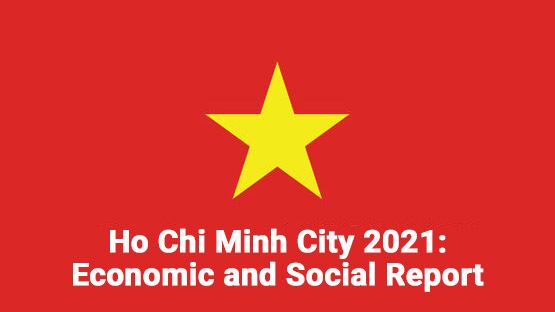
Ho Chi Minh City 2021 Report from Statista brings comprehensive and up-to-date essential data, including the society, economy, operational environment, and charisma. The report also compares some of the vital information of the city with the 200 most influential business cities from 73 countries and territories around global and Southeast Asia. Download the report to see detailed data from Statista or read our analysis in the article below.
Ho Chi Minh City ranked 145th out of 200 Global Business Cities.
The Global Business City index value is from 0 to 100; this score is calculated based on four indexes: Economy and Operational, Environment, Society, Charisma. The Global Business Cities Index 2020 covers 200 cities, which implies the recognition of the influence of one city on the global economy through its socioeconomic, cultural, and political means that other ordinary cities do not have.
With a total score of 35.47 points, Ho Chi Minh city ranked 145th out of 200 Global business cities according to the Statista 2020 report. The highest index belongs to Tokyo (Japan). Another impressive Asian city in the top 10 Global Business cities index in Hong Kong ranked 7th. In the same year, Hanoi capital ranked 134th with a total score of 38.87 points.
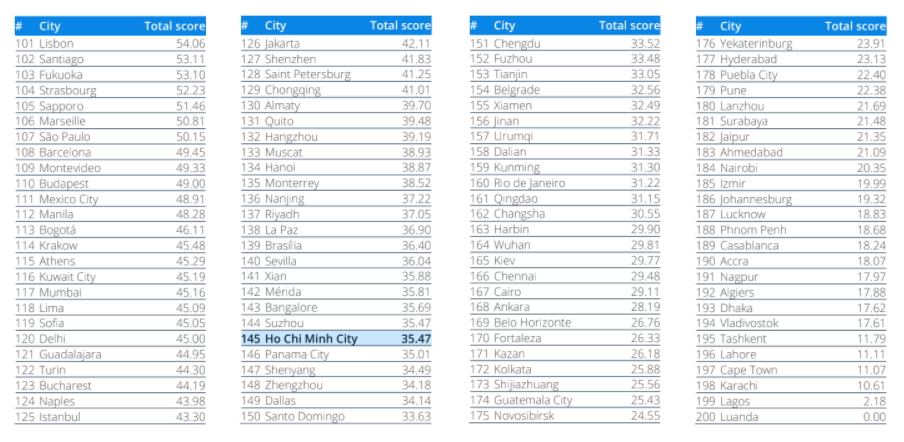
In 2020, the total population of Ho Chi Minh city reached 8.6 million people, with a growth rate 2020-2030 predicted at 28.5%. The average cost to live in Ho Chi Minh city was around 25 thousand US$. With more than 8.6 million residents, the city product per capita in Ho Chi Minh City reached nearly 5000 USD/person. In one year, the air passengers reached 38.5 million, with 15 universities in the city.
Tan Son Nhat Ho Chi Minh City Airport (SGN) is the largest international airport in Vietnam, mainly located in Ho Chi Minh city. Tan Son Nhat Airport is a large 850ha that is 8km away from the city center. Other Tan Son Nhat Airport airports include Can tho (VCA) and Rach Gia (VKG).
The society subindex is calculated based on the following elements: Population Growth, Total Population, Life Expectancy, English Proficiency, Years of Schooling, Gay Rights, and Press Freedom.
The Society score in Ho Chi Minh city was 10.19 points in 2020, ranking 108th out of 200 Global business cities. As the most dynamic city in Vietnam, Ho Chi Minh City is growing faster than an average city in this region in 2020. According to the report, the total population of HCMC in 2020 reached 8.6 million people and is predicted to increase 28.5% to reach 11.1 million in 2030. Southeast Asia's total population reached 7.5 million in the same year and is predicted to increase more than 20% to reach 9 million people in 2030. This number is lower than HCMC's total population.
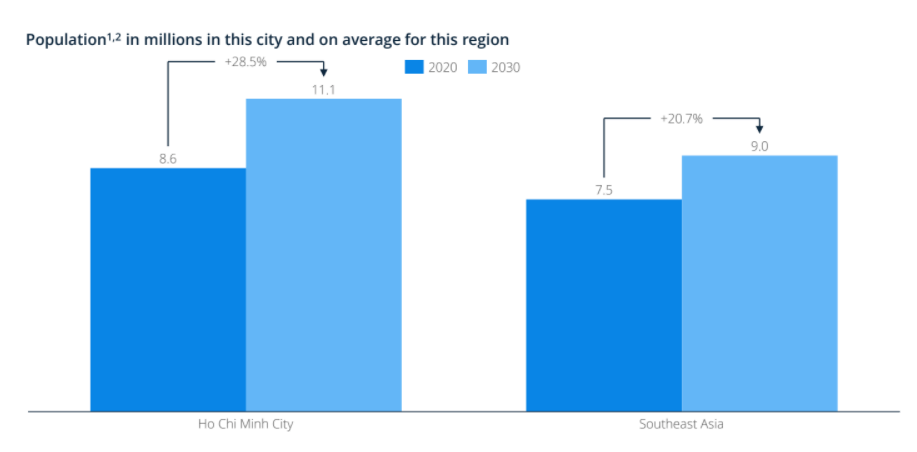
In contrast with the faster-growing population, the education in Ho Chi Minh city is negative when the inhabitants have 3.6 years less education than in the highest regional performer. Mean years of schooling in Ho Chi Minh was at 8.7 points, 3.6 points behind the highest one in Kuala Lumpur City in 2018, according to the Global DataLab 2020.
According to the report, Ho Chi Minh city has a low Education First English Proficiency Index score of 477 points, higher than the country level of 473 points. In 2020, the countries with the highest English proficiency score was the Netherlands with 652 points, followed by Denmark, Finland, Sweden, and Norway with 632, 631, 625, and 624, respectively.
Among two leading economic, political and educational centers in Vietnam, Ho Chi Minh City is also the largest area in the country. Ho Chi Minh is diverse culturally; immigrants from small provinces come to the city to live and work, increasing the population of Ho Chi Minh City. As a result, the cost of living in Ho Chi Minh city is higher than in other cities and provinces, according to the residents. But in the Statista report, the cost of living in Ho Chi Minh city was still lower than in this region in general.
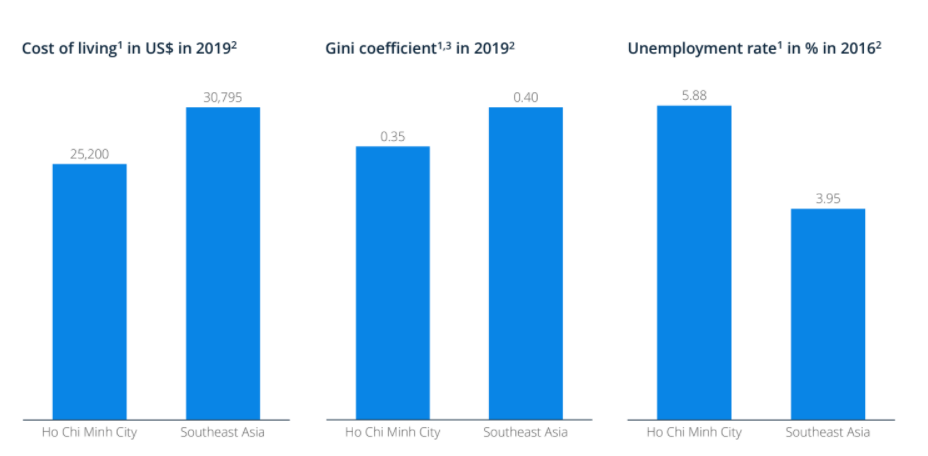
In 2019, the cost of living in HCMC was 25,200US$, while in the same year, the cost of living in Hanoi was 27,480 US$. This amount is lower compared to regional Southeast Asia (30,795US$/month).
The average life expectancy at birth is also one of the essential indicators to assess the level of development of a country, a region, or a locality; it is a component of the human development index (HDI).
According to the World Bank 2019 and Statista 2019, the average life expectancy of Ho Chi Minh City residents in 2019 is 75.8 years old, ranked 135th out of 200 global business cities report.
The Safety Index is considered critical data that many people are concerned about before business immigration. This score of Safety Index values between 1 and -1 and is calculated based on many factors, including homicide rates, the estimated risk of kidnapping, the security risk, and the political risk.
With the Safety Index score of 0.56 points, Ho Chi Minh city is considered unsafer than the regional average (>0.6 points). Although higher than HCM city, the Safety Index of Hanoi capital is still lower than the regional average and is considered unsafe.
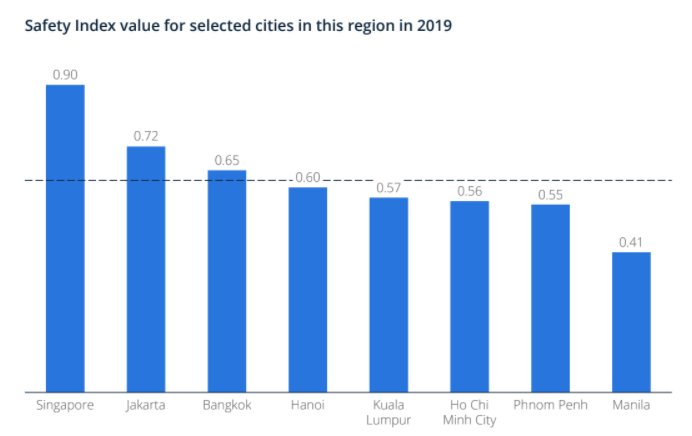
In 2020, Ho Chi Minh city contributed about 23% to the country's GDP and about 27% of the national budget. On average, HCM city attracts more than 33% of the country's total foreign direct investment projects. The Economic Subindex of Ho Chi Minh city's score of 16.04 points ranked 172nd out of 200 Global business cities.
The COVID-19 outbreak in 2020, but Vietnam was expected to become the favored destination for companies pulling out of China by their pandemic's good control. Unfortunately, the fourth wave of the pandemic in the middle of 2021 in Vietnam with the Delta showed negative when Ho Chi Minh was locked down for more than 90 days. Before the risk of the epidemic still exists, Ho Chi Minh City decides to go back to a new normal state, restore and develop socioeconomic status at the end of the year.

The city GDP per capita of Ho Chi Minh city in 2019 was 4931US$, lower than Hanoi and being US$73,832 behind regional high-performer Singapore.
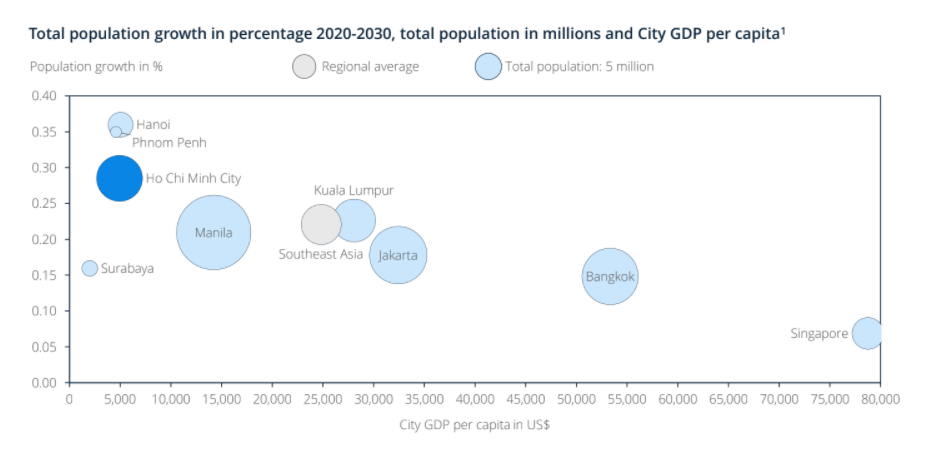
Some experts say that a GDP per capita of $12,000-15,000 per year is enough to put a country in the developed group. However, others believe that the GDP per capita must be at least $25,000-30,000. According to World Bank (WB) data, GDP per capita of some typically developed countries in 2019, such as the US 65,111 USD/year, Australia 54,907 USD/year, Germany 46,259 USD/year, Japan Version 40,847 USD/year. The highest regional performer - Singapore's GDP per capita reached 78,763 US$, nearly 16 times higher than Ho Chi Minh's GDP per capita.
The number of newly-established enterprises in Vietnam tends to increase year by year. This trend is a result of the improvement of the business environment. In reality, the Statista report showed that people need 16 days to start a business in Vietnam, compared to the regional average of 34.9 days. Besides, the time needed to register property and other tasks, including fulfilling tax requirements, is lower than the regional average.
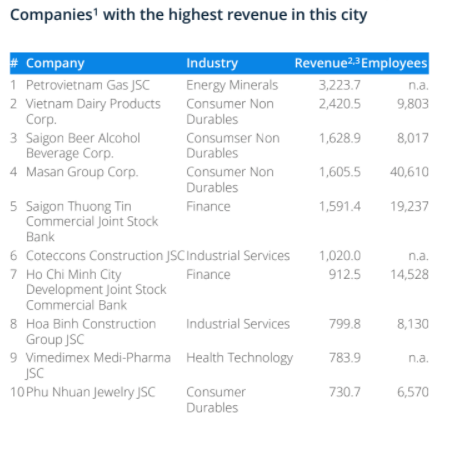
In 2020, there were 129 businesses located in Ho Chi Minh city that had revenue above US$5 million, according to Statista.
The number of international tourists visitors in Ho Chi Minh City has always accounted for nearly 54 to 66% of the total number of foreign visitors to Vietnam in the past 5 years. With many foreign visitors, the International hotel brands are not well represented in Ho Chi Minh City. Some international hotel brands represented in this city include Hyatt, Holiday Inn, DoubleTree, Mercure, and Intercontinental. In contrast, international restaurant chains show a strong presence in this city, including Starbuck, Macdonal, KFC, Domino Pizza, Pizza Hut, Dunkin…
The population in Ho Chi Minh City is nearly 13 million people, including about 3 million immigrants. The large population, accounting for 9.3% of the country's total population, but the city area square accounts for 0.6% of the country's area, causing the population density to increase very high. This also made the monthly house rent in Ho Chi Minh city increase rapidly through the years.
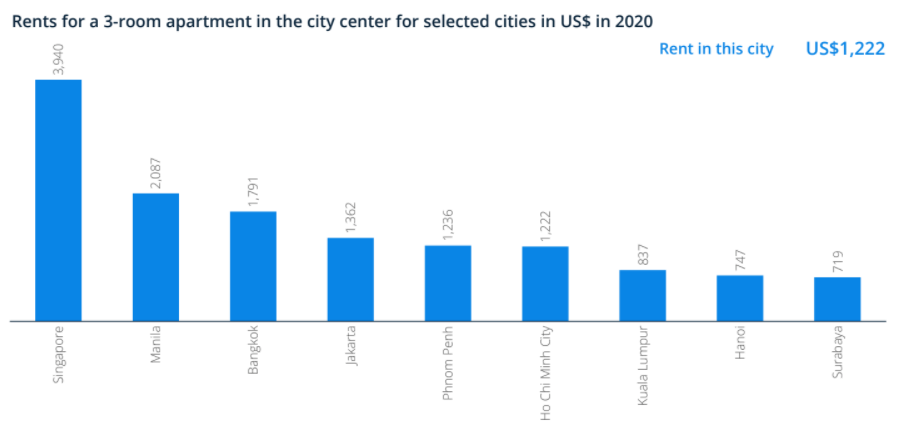
The average monthly rent for a 3-room apartment in Ho Chi Minh city center was US$1,222, being US$2,718 lower than the highest for this region. The average monthly rent outside the city was lower at the cost of US$809, being US$927 lower than the highest for this region.

The Real Estate Index of Ho Chi Minh city was 0.76 points, higher than Hanoi's score (0.71) and higher than the regional average (0.66). The Real Estate Index is calculated based on the stability, affordability, and level of taxation of the city's property market. A higher score denotes a higher ranking in the Real Estate ranking.
The Operational Environment subindex score value between 0 and 35 points is calculated from these factors: number of Physicians, Number of Universities, Air Passengers, Air Freight, Internet penetration, and Smartphone Penetration. The higher score denotes a higher ranking of the city out of 200 Global Business Cities.
Ho Chi Minh City has the Operational Environment score at 14.91 points, being 20.09 behind the highest Operational Environment Index - Tokyo. HCM City ranked at 113th out of 200 Global Business Cities.

The internet penetration in Ho Chi Minh City is higher than the regional average. In 2016, Ho Chi Minh city's smartphone penetration rate was at 74.9%, being 1.7% behind the regional average rate. HCM City's internet penetration rate in 2020 reached 75.7%, higher than the regional average rate (70.8%).
Ho Chi Minh City Stock Exchange officially became operational on July 20, 2000. According to the latest statistics, up to March 2021, there are 56 securities companies with 99 Headquarters / Branches / Transaction Offices in Ho Chi Minh City (HCMC). Some of the popular stock exchanges trading agencies in Ho Chi Minh city include VPS, SSI, HSC, VNDIRECT,...
According to the Global Business Cities Reports, Uber and inDriver are ride-hailing apps used in Ho Chi Minh City. The proportion of the population with access to public transport accounts for 69%, higher than the regional average (50%). The main transportation options in this city include bus, ferry, and bike-sharing.
Ho Chi Minh city's Air passenger numbers in 2018 were 38.50 million people, lower than the regional average at 44.26 million people. The Airfreight in 2019 reached 218.45 thousand metric tons, being 539.3 million people behind the regional average.
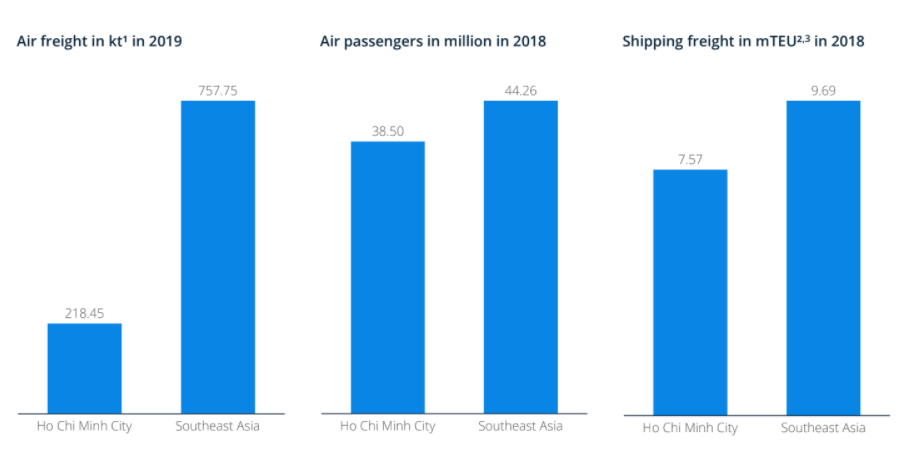
In 2020, there will be 0.83 physicians per thousand people in Ho Chi Minh city. Regarding the development orientation 2021-2026, the City's Department of Health said that the city's health sector strives to reach 21 doctors per 10,000 people; 40 nurses/10,000 people.
As the country's economic center, Ho Chi Minh City has 38 public universities, 8 academies, and 15 private universities. According to the planning scheme, by 2020, Vietnam will have 19 universities, universities, and academies belonging to the national key universities, 5 of which are located in Ho Chi Minh city.
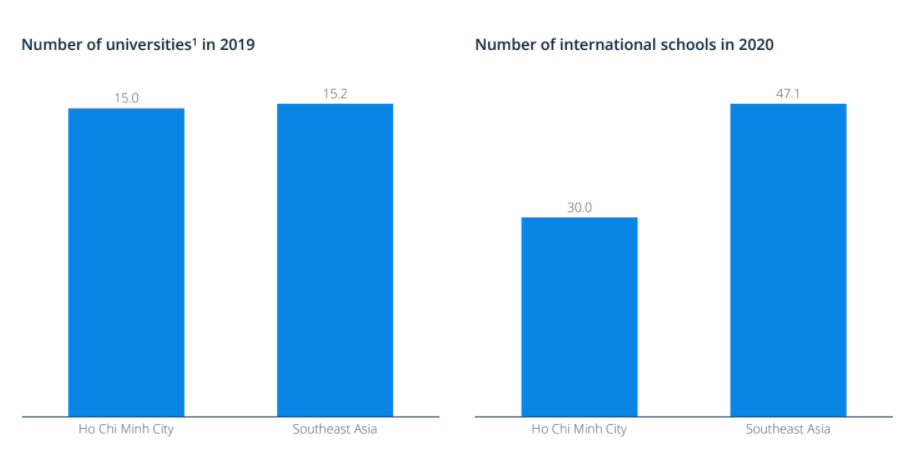
There are 15 universities in HCM city in 2019, lower than the regional average. The number of international schools in 2020 was 30, lower than the regional average.
The Charisma Subindex of Ho Chi Minh City score of 2.5 points, being 7.5 points behind the highest performers Tokyo, made this city ranked 169th out of 200 Global Business Cities.
There are 23 embassies or consulates in this city, lower compared to Hanoi that has 49 embassies or consulates. Although attracting more than 50% of the total number of foreign visitors to Vietnam, Ho Chi Minh city was less famous on Instagram than other cities in this region. Ho Chi Minh has one of the UNESCO heritage sites and 15 sister cities. The number of museums in Ho Chi Minh city is also higher than the regional average. According to the reports, HCMC will have 68 museums in 2020 while Southeast Asia will lower with 63 museums.
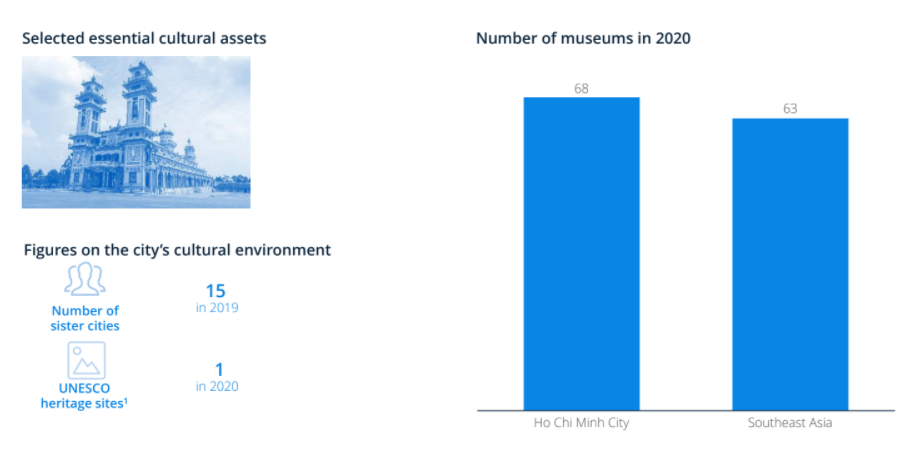
Pollution is a problem that needs more attention in Ho Chi Minh City as well as Hanoi. Vietnam is a developing country, going up to industrialization and modernization. Therefore, domestic and foreign investment enterprises are facilitated to develop as much as possible. Ho Chi Minh City is the leading center for the development of an industrialized economy. And this is the main reason for environmental pollution. The problem of environmental pollution in the city is alarming with many different types of pollution such as surface water pollution, air pollution, noise, light, etc.
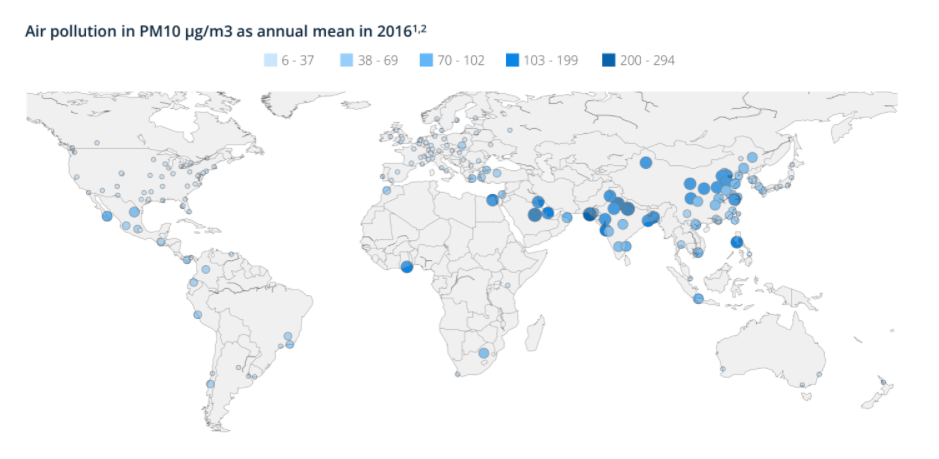
According to WHO 2018, Statista 2020 report, the air pollution concentration of Ho Chi Minh city in 2020 at 90 μg/m3 was 350% higher than the WHO guideline.
The Statista brings us with careful research and data about the biggest city in the country. Along with the economic development information, some other index shows that Ho Chi Minh city is still one of the ideal places for foreign investors and Vietnamese investors. To get complete data and information about Ho Chi Minh city in 2020, you can download the report directly by clicking on the button above or chatting with us if you need a consultant about the change to develop your business in this city.